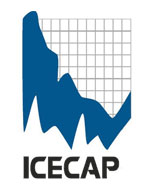Jul 24, 2025
WSJ Claim: Extreme Weather Driving Global Food-Price Surges
By Joseph D’Aleo, Meteorologist/Climatologist
The authors claim: Extreme weather events are driving short-term surges in food prices around the world. Until we get to net-zero emissions, extreme weather will only get worse, but it’s already damaging crops and pushing up the price of food all over the world. The spikes are linked to heat, drought and heavy rainfall conditions, the report said.
Actually, extremes of weather are part of our climate system and are not worsening.
The warming that is claimed is primarily at nights and focused in urban locations. The urban heat island as it is called, actually reduces freeze and frost problems, benefiting crops early and late in the season. Daytime heat was far worse a century ago. The urban heat island drives an exaggerated view of climate change. This was recognized by NOAA when the temperature data was first introduced.
National Climate Data Center Director Tom Karl’s paper defined the Urban Heat Island (UHI) adjustments for the first version of its first Climate network USHCN in 1988:
He wrote “… trends of surface air temperature computed predominantly from urban station data are likely to have a serious warming bias of 0.34C/decade (about 6F/century)… The rate may have increased after the 1950s, commensurate with the large growth in and around airports (up from 20% to over 70%).
“Our results and those of others show that this ‘urban growth’… is serious and must be taken into account ... assessing temperatures.”
The Urban Heat Island in the 1970s and 1980s was increasingly recognized as a data contaminant that reflected a diminished cooling at night due to heat that was trapped in the urban areas.

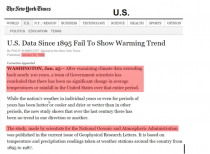
Crops are not grown in urban areas where growing urban heat island are resulting in slower cooling and higher temperatures at night. The original temperature data starting in the late 1980s had to be adjusted for the local nighttime trapping of heat. In 2000, the corrected data was showing the Dust Bowl heat of the 1930s were still warmest.
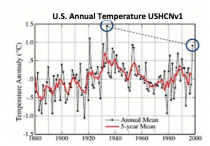
Inexplicably, the UHI adjustment Karl argued for was removed in USHCNv2 in the early 2000s.
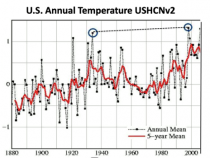
NASA’s Dr. Edward Long in 2010 showed how the urban areas are warming with rural areas showed little change (mostly explained by ocean and solar cycles).
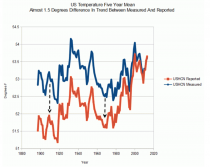
For more truthful tracking of the cycles, University of Alabama Huntsville, Climatologists Dr. John Christy and Roy Spencer, defined a subset of stations that are properly sited and not contaminated by urbanization in the country at nights. The US Climate Reference Network record from 2005 shows no obvious warming during this period. Each month, this data is updated by NOAA and Watts Up with That.

The graph shows the Average Surface Temperature Anomaly for the contiguous United States since 2005. The data comes from the U.S. Climate Reference Network (USCRN) which is a properly sited (away from human influences and infrastructure) and state-of-the-art weather network consisting of 114 stations in the USA.
These station locations were chosen to avoid warm biases from Urban Heat Islands (UHI) effects as well as microsite effects as documented in the 2022 report Corrupted Climate Stations: The Official U.S. Surface Temperature Record Remains Fatally Flawed. Unfortunately, NOAA never reports this data in their monthly or yearly “state of the climate report.” And, mainstream media either is entirely unaware of the existence of this data set or has chosen not to report on this U.S. temperature record.
CROP YIELDS
The nighttime warmth in the cities has no effect on crops, largely because crops are grown in rural areas.
Yields for crops continue to rise. Our yields for corn, beans and wheat are routinely setting new records. The occasional drought year is the exception not the rule and when they come the yields are higher than previous droughts.
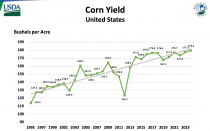
DAYTIME TEMPERATURES ARE NOT AFFECTED
Almost all (24 of 50 states) set their all-time record highs in the 1930s.
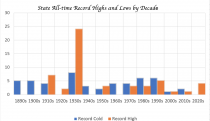
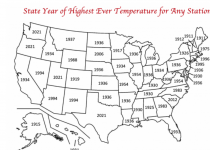
Jul 12, 2025
Wisconsin’s climate isn’t in crisis
By H. Sterling Burnett
While climate scientists continue to debate the causes and possible consequences of climate change in general, what Americans really want to know is if climate change will impact their daily lives.
For this reason, The Heartland Institute has started a project that analyzes the impact of climate change at the state level. Mind you, climate models, contrary to their promoters’ claims, fail to model global climate fundamentals accurately. They don’t even get measured temperatures and trend lines right. They do even worse in tracking and forecasting changes at a regional scale than they do in their global assessments. Thus, climate models are virtually worthless in assessing what types of climate-related challenges individual states currently and may soon face. For that, one needs to turn to the data, which is the foundation for all good science.
Looking at Wisconsin, one finds that climate change not only poses no existential threat to the well-being of Wisconsinites but that it has actually benefited them in various ways.
Like much of the United States, Wisconsin’s average temperature has increased modestly since the late 1800s. In the Badger State, the increase has been 2 degrees F. However, some of the rise in average temperature is due to factors unconnected to long-term climate change.
Many surface station sites, primarily those in or near urban and suburban areas that have experienced growth over the past century, are reporting biased temperature readings. They are reporting higher average temperatures and a faster rate of change than temperature readings from nearby rural stations that have not been impacted by the development of artificial heat sources.
More pavement, buildings, concrete, and heat-generating and shedding machinery have compromised the accuracy of temperature measurements. Evidence of the urban heat island effect on Wisconsin’s reported temperature rise is confirmed not just by a comparison of rural and urban stations but also because of when the reported rise is being recorded—at night.
The artificial surfaces accompanying development absorb heat during the day only to release it slowly overnight, as evidenced by infrared cameras. So, Wisconsin’s temperature increase is largely a by-product of a slight increase in nighttime low temperatures.
The good news is that the modest warming has not been accompanied by an increase in extremely hot days, which, in fact, have declined in recent decades, according to the Wisconsin State Climate Summary assembled by the National Oceanic and Atmospheric Administration.
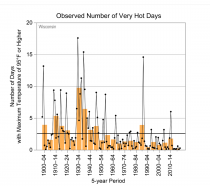
Enlarged
Rather, the increase in state temperatures, not accounted for by urban heat bias, is due to a decline in extremely cold temperatures during the winter. That’s right, Wisconsin’s historically bitterly cold, life-claiming winters have become moderately less severe with a slight rise in nighttime winter low temperatures. This is a welcome development because research consistently shows cold temperatures take far more lives than hot temperatures. Over the decades, deaths caused by very cold temperatures have declined in Wisconsin. Who could complain about that?
Temperatures and the timing of temperature changes have effects beyond the thermometers. The moderate warming in Wisconsin has been accompanied by a slight increase in summer and winter precipitation. The number and frequency of droughts have declined over the past century as precipitation frequency and amounts have increased.
This rise in precipitation has also not been associated with an increase in the frequency or severity of flooding in the state or increased tornado strikes.
Additionally, the lengthened spring growing season, with fewer late-season crop-killing frosts, coupled with higher carbon dioxide concentrations, has been a boon for Wisconsin’s important agriculture industry. Wisconsin’s cheese production has increased by 87 percent since 1990. Corn and soybean production increased by 45% and 477%, respectively, over the same period. Cranberry production, which has been regularly monitored since 2007, has increased by 43 percent.
Of course, botany and agronomy explain the increase in production. Carbon dioxide (CO2) is plant food, helping plants grow faster and larger.
In the end, Wisconsin, like the entire world, is going through a period of climate change. But regardless of the role humans may or may not be playing in the present modest shift, contrary to the impression often given to Wisconsin’s residents by the mainstream media, there is no crisis.
Contrary to the endless predictions of an approaching climate Apocalypse, living conditions in Wisconsin have improved amidst modest warming.
H. Sterling Burnett, Ph.D., (hsburnett@heartland.org) is the Director of the Arthur B. Robinson Center on Climate and Environmental Policy at The Heartland Institute, a non-partisan, non-profit research organization.
Jun 26, 2025
It’s Hot Weather but not Manmade
By Steve Goreham
This week the United States experienced the first major heat wave of 2025. Over 160 million people in the Midwest, the South, and the East Coast experienced temperatures approaching 100F. Many in the media claim that the soaring temperatures are due to human-caused global warming. But a look at history shows that such high temperatures have been experienced many times in the past.
Extreme heat warnings were issued in Baltimore, Boston, New York City, Philadelphia, and Washington D.C. The Washington Monument was closed due to the heat. Dozens of daily high temperature records were broken. Heat indexes, which combine temperatures and the effects of humidity, exceeded 100 in Chicago, Pittsburgh, Philadelphia, and other locations.
Many media outlets reported that humans are responsible for the current hot weather. CNN reported that “heat waves are getting more dangerous with climate change” and that the current heat wave “bears the hallmarks of human-caused global warming.” NPR concluded that “human-caused climate change has made this heat wave three times more likely” due to emissions from “burning of coal, oil and gas.” Time stated that heat waves now occur “three times as often"in the United States as they did in the 1960s. But historical records do not support the media alarm about heat waves.
The National Oceanic and Atmospheric Administration (NOAA) tracks state record high temperatures and the date when they occur. The data shows that 36 of the 50 state record highs were set more than five decades ago. Twenty-three state record high temperatures occurred in the decade of the 1930s, when annual human CO2 emissions were less than one-eighth of today’s emissions. Despite endless headlines about heat waves, only 6 state high temperature records have occurred since the year 2000.
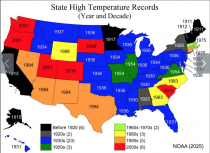
Enlarged
New York City temperatures rose to 102F at the peak of the heat wave. But the record high temperature for New York State is 108F, set in 1926, 99 years ago, in Troy, New York. Memphis temperatures reached 95F. But the record high temperature for Tennessee is 113F, set in Perryville in 1930. Richmond, Virginia temperatures reached 99F, but lower than the state record high temperature of 110F, set in Balcony Falls in 1954.
Temperature metrics from the National Aeronautics and Space Administration (NASA), NOAA, and the Climate Research Unit at the University of East Anglia in the United Kingdom (Met Office) show that average global surface temperatures have risen about 1.2C (2F) in the last 140 years. But is this rise caused by industrial emissions of greenhouse gases?
The Central England Temperature Data Set, provided by the Met Office Hadley Centre of the UK, is the world’s longest-running temperature metric. It shows that Central England temperatures have risen about 2C (3.6F) over the last 360 years, since 1660. Human carbon dioxide annual emissions were negligible until after World War II, but emissions have since increased by a factor of almost eight times. Yet the rate of change in the rise of Central England temperatures appears to be unchanged during the age of spiking global CO2 emissions. The evidence shows that temperatures are dominated by natural factors and that human emissions play only a small role in global warming.
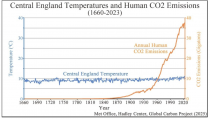
Enlarged
Beware the high temperatures of heat waves this summer, drink plenty of fluids, and stay cool. Understand that temperatures in most locations have been warmer during past decades. Since nature drives Earth’s climate, our only sensible course of action is to adapt to climate change and rising temperatures.
Steve Goreham is a speaker on energy, the environment, and public policy and author of the bestselling book Green Breakdown: The Coming Renewable Energy Failure.
Jun 06, 2025
Climate-Obsesseds’ Infantile Reading of Polar Ice
By Vijay Jayaraj
CO2 Coalition Science and Research Associate Vijay Jayaraj reports on recent revelations that both Arctic and Antarctic sea ice are growing, not shrinking, as has been claimed by the “experts."” Below is a portion of his reporting.
Both the North and South Poles are defying expectations, piling on more ice despite, as reported in hyperbolic headlines, “record-breaking” global heat.
In the post-2010 era, the September minimum extent of Arctic sea ice occurred in 2012, which was also the lowest since satellite measurements began in 1980. But since 2012, ice has been increasing or oscillating well above that year’s mark.
As in the Arctic, Antarctic temperature and ice coverage are refusing to cooperate with predictions of doom by the climate bedwetters. Data from Vostok and Concordia stations in East Antarctica indicate extremely cold temperatures in early May, with minimums of minus 106.6 degrees Fahrenheit at Concordia on May 12.
As recently as 2023, Concordia station recorded one of its lowest temperatures for the current decade, a brutal minus 117.76 degrees. Similarly, at Western Antarctica’s Byrd Station, a likely all-time low of almost minus 50 degrees was recorded as recently as 2023. These numbers may be surprising, but they are in tune with the unpredictability of climate - and of nature in general.
Let’s just admit it. Things are not as “straightforward” as crisis-obsessed scientists are making it out to be. The climate system is complex, and the science is not settled. Our understanding of climatic dynamics is in its infancy. And to suggest that changes - whatever the direction - in polar ice presages a catastrophe is infantile.
See the May ice which has leveled off the last decade.
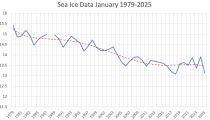
Enlarged
See the annual September NASA ice minima which show the leveling off the last decade.
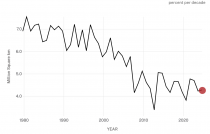
Enlarged
------------------
Read Vijay’s entire commentary below.
Whenever “experts are shocked” they usually have marginalized or ignored altogether factors wrongly assumed to have no influence over their hypotheses, theories or beliefs.
Nowhere is this more evident than in climate science where changes in geophysical phenomena continue to defy assumptions and forecasts presented by some of the most highly paid and influential scientists on the planet.
Among the most infamous examples is the failure of computer climate models to accurately predict real-world temperatures. This is predominantly due to the unscientific exaggeration of carbon dioxide’s (CO2’s) potency in warming the atmosphere.
Now scientists have encountered more “shocks” as polar sea ice is refusing to behave as expected. Since September 1, 2024, an astonishing 579 billion tons of fresh snow and ice have blanketed the Greenland ice sheet, marking the most significant accumulation for that date in at least eight years - far surpassing the 1981-2010 average.
Meanwhile, both the North and South Poles are defying expectations, piling on more ice despite, as reported in hyperbolic headlines, “record-breaking” global heat. It’s a breathtaking, almost surreal twist in the story of our planet’s climate!
According to NASA, “Arctic sea ice reaches its minimum extent (the area in which satellite sensors show individual pixels to be at least 15% covered in ice) each September.”
In the post-2010 era, the September minimum extent of Arctic sea ice occurred in 2012, which was also the lowest since satellite measurements began in 1980. But ever since 2012, ice has been increasing or oscillating well above that year’s mark.
Likewise, the volume of sea ice has not significantly dropped since 2012 and there has been a nominal increase in volume since a low point of 2020.
So, why is the minimum coverage of Arctic sea ice holding above the level of 2012?
One of the most obvious reasons could be that CO2 is not as powerful a temperature control knob, which is a possibility that many well-funded scientists refuse to even take into consideration.
Also, remember that we are in the Holocene epoch, a warm geological phase between two glacial advances - one that ended about 10,000 years ago and the next expected to occur some number of thousand years hence. An upward tick in Arctic temperatures shouldn’t surprise us regardless of whether we emit CO2 or not.
In fact, Arctic ice levels witnessed in the 17th century during the Little Ice Age was one of the highest since continental glaciers blanketed Canada and extended into the lower 48 states to create the Great Lakes.
At one point, news media were abuzz with the unexpected gain in Antarctica’s ice mass. Antarctica gained ice from 2021 to 2023, with studies showing nearly 108 gigatons per year added, mainly due to increased snowfall in East Antarctica.
Data from Vostok and Concordia stations in East Antarctica indicate extremely cold temperatures in early May, with minimums of minus 106.6 degrees Fahrenheit at Concordia on May 12. With winter just beginning the temperatures are likely to dive further.
As recently as 2023, Concordia station recorded one of its lowest temperatures for the current decade, a brutal minus 117.76 degrees. Similarly, at Western Antarctica’s Byrd Station, a likely all-time low of almost minus 50 degrees was recorded as recently as 2023. These numbers may be surprising, but they are in tune with the unpredictability of climate - and of nature in general.
Let’s just admit it. Things are not as “straightforward” as crisis-obsessed scientists are making it out to be. The climate system is complex, and the science is not settled. Our understanding of climatic dynamics is in its infancy. And to suggest that changes - whatever the direction - in polar ice presages a catastrophe is infantile.
Vijay Jayaraj is a Science and Research Associate at the CO₂ Coalition, Arlington, Virginia. He holds an M.S. in environmental sciences from the University of East Anglia and a postgraduate degree in energy management from Robert Gordon University, both in the U.K., and a bachelor’s in engineering from Anna University, India.
May 31, 2025
United States and Global Data Integrity Issues - oldie from 2009
Joseph D’Aleo ICECAP, Academia USA
ABSTRACT
Issues with the United States and especially the global data bases make them inadequate to use for trend analysis and thus any important policy decisions based on climate change. These issues include inadequate adjustments for urban data, bad instrument
siting, use of instruments with proven biases that are not adjusted for, major global station dropout, an increase in missing monthly data and questionable adjustment practices.
We hear official press releases announcing 2008 was the 8th, 9th or tenth warmest in 127 to 147 years in the various global data bases. Yet the NASA satellite record shows the year for the globe was the coldest this decade and 14th coldest in the 30 years of satellite monitoring. Here we will show how these global estimates are contaminated and can’t be trusted and certainly should not be used for important policy decisions.
US CLIMATE DATA
NOAA NCDC USHCN
When first implemented in 1990 as USHCN version1, it employed 1221 stations across the United States. In 1999, NASA’s James Hansen published this graph of USHCN version 1 annual mean temperatures:

Enlarged
About which Hansen correctly noted: “The U.S. has warmed during the past century, but the warming hardly exceeds year-to-year variability. Indeed, in the U.S. the warmest decade was the 1930s and the warmest year was 1934.”
USHCN was generally accepted as the world’s best data base of temperatures with the stations most continuous and stable, and adjustments made for time of observation, urbanization, known land use changes around sites, and instrumentation changes, each of
which can produce major contamination issues for temperature data.
URBAN HEAT ISLAND
There is no real dispute that weather data from cities, as collected by meteorological stations, is contaminated by urban heat island (UHI) bias, and that this has to be removed to identify climatic changes or trends. In cities, vertical walls, steel and concrete absorb the sun’s heat and are slow to cool at night. More and more of the world is urbanized (population increased from 1.5 B to 6 B in 1900s).
The UHI effect occurs not only for big cities but also for towns. Oke (who won the 2008 American Meteorological Society’s Helmut Landsberg award for his pioneer work on urbanization) had a formula for the warming that is tied to population. Oke (1973) found
that the UHI (in C) increases according to the formula
UHI= 0.73 log10 POP
where pop denotes population. This means that a village with a population of 10 has a warm bias of 0.73C, a village with 100 has a warm bias of 1.46C, a town with a population of 1000 people has a warm bias of 2.2C, and a large city with a million people has a warm bias of 4.4C.
Urban heat islands as seen from infrared sensors onboard satellites. Goodrich (1996) showed the importance of urbanization to temperatures in his study of California counties in 1996. He found for counties with a million or more population th warming from 1910 to 1995 was 4F, for counties with 100,000 to 1 million, 1F and for counties with less than 100,000, no change (0.1F).

Enlarged
NCDC’s Tom Karl (1988) employed a similar scheme for the first USHCN data base (released in 1990) that was the best data set available at that time. He noted that the national climate network formerly consisted of predominantly rural or small towns with populations below 25,000 (as of 1980 census) and yet that a UHI effect was clearly evident.

Enlarged
Tom Karl etal’s adjustments were smaller than Oke had found (0.22C annually on a town of 10,000 and 1.81C on a city of 1 million and 3.73C for a city of 5 million). Karl observed that in smaller towns and rural areas the net UHI contamination was relatively small but that significant anomalies showed up in rapidly growing population centers.
USHCN also maintained a METADATA base (not perfect) that identified changes in observing site locations and instrumentation and supposedly made adjustments accordingly, along with adjustment for change in the time of observation over the years.
See full story with enlarged graphics here.
|









